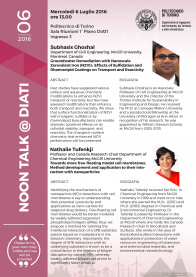06 - NoonTalk@DIATI - 2 seminari
Mercoledì 6 luglio 2016 - ore 13:00 - Sala Riunioni 1° Piano DIATI ingresso 3, Politecnico di Torino - Corso Duca degli Abruzzi 24, Torino
GROUNDWATER REMEDIATION WITH NANOSCALE ZEROVALENT IRON (NZVI): EFFECTS OF SULFIDATION AND RHAMNOIPID COATINGS ON TRANSPORT AND REACTIVITY - Seminario con Subhasis Ghoshal
BIOGRAFIA - Subhasis Ghoshal is an Associate Professor of Civil Engineering at McGill University and the Director of the Trottier Institute for Sustainability in Engineering and Design. He received his Ph.D. at Carnegie Mellon University and a postdoctoral fellowship at the University of Michigan at Ann Arbor. In recognition of his research, he was appointed as William Dawson Scholar at McGill from 2005-2015.
ABSTRACT - Past studies have suggested various surface and aqueous chemistry modifications to enhance NZVI transport or reactivity, but few have assessed modifications that enhance both transport and reactivity. We show that surface functionalization of NZVI with inorganic sulfides or by rhamnolipid biosurfactants can enable dramatic (positive) effects on its colloidal stability, transport, and reactivity. The changes in surface chemistry that enhanced NZVI performance will be presented.
TOWARDS MORE FREE-FLOATING MODEL CELL MEMBRANES: METHOD DEVELOPMENT AND APPLICATION TO THEIR INTERACTION WITH NANOPARTICLES - Seminario con Nathalie Tufenkji
BIOGRAFIA - Nathalie Tufenkji received her B.Sc. in Chemical Engineering from McGill University in 1999 and went on to Yale, where she earned the M.Sc. (2001) and Ph.D. (2005) degrees in Chemical and Environmental Engineering. Dr. Tufenkji is presently Professor in the Department of Chemical Engineering at McGill where she holds the Canada Research Chair in Biocolloids and Surfaces. She works in the area of (bio)colloid-surface interactions with applications in protection of water resources, engineering of biosensors and antimicrobial materials, and environmental nanotechnology.
ABSTRACT - Identifying the mechanisms of nanoparticle (NP) interactions with cell membranes is key to understanding their potential cytotoxicity and applications as nano-carriers for targeted drug delivery. Free-floating cell membranes would be better modeled by weakly adhered supported phospholipid bilayers (SPBs); thus, we propose a method for tailoring the interfacial interaction of a SPB-substrate system based on modulations in the solution chemistry. Importantly, the degree of SPB interaction with its underlying substrate is shown to be a critical factor in the kinetics of bilayer disruption by cationic NPs, whereby weakly adhered bilayers are prone to significantly faster breakup.

